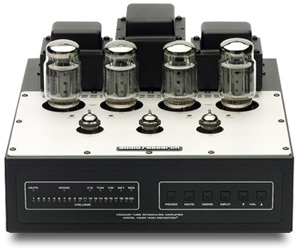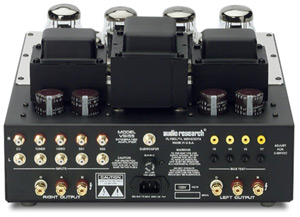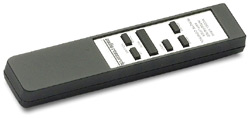![[SoundStage!]](../titles/sslogo3.gif) Home
Audio Home
Audio Equipment Review |
||||||||||||||||
October 2003 Audio Research VSi55 Integrated Amplifier by Aaron Weiss
A friend recently asked, "What is it like having a well?" Indeed, the thought that I had bought a house that drew its water supply from under the very ground the house sits on seems oddly novel in a modern world. I replied that in practice there’s very little difference from public water -- you turn on the tap and water comes out. It’s not as if we ferry wooden buckets on our heads from well to bathtub. But, get this -- the water actually tastes great and is basically free. Tube amplifiers don’t share a whole lot in common with wells -- for one thing, you certainly shouldn’t put them in water -- but in a way they serve as a reminder that older technologies can sometimes meet modern needs, occasionally with surprising advantages. Like the conveniences of the electric pump and water softener that pressurize and treat my groundwater, tube amplification can be paired with contemporary technologies such as microprocessors to achieve the best of both worlds. Tube lovers have always praised vacuum-tube technology for its "natural" sound, in contrast to the perceived harshness of solid-state gear. Distortion is to thank, specifically tubes’ penchant for producing even-order distortion -- the kind that pleases many a pair of ears. Tube diehards have always known this and espoused a kind of naturalness-as-accuracy dogma that sometimes borders on zealotry. Unfortunately this has led to many quarrels with solid-state supporters -- beer steins are thrown, accusations of tone-deafness fly, and otherwise grown men ultimately sulk on the shoulders of their nonplussed spouses. Fortunately, vendors such as Audio Research Corporation hope to bring peace on Earth as they introduce ever-more-accessible tube amplifiers at increasingly affordable prices. Details Minnesota-based Audio Research Corporation is a veteran of the audio-tube industry. In fact, the company and its founder, William Johnson, played a large role in resuscitating vacuum-tube technology in high-end audio at its founding in 1970. The $2995 VSi55 tube integrated amplifier is based on the design of the popular and respected VS55 power amplifier. The company’s deep product catalog includes full lines of preamps and power amps, as well as very pricey Reference-series monoblocks and even a CD player. In this context, the VSi55 represents a budget-oriented release from Audio Research. The push-pull VSi55 delivers 50Wpc via output taps for both 4- and 8-ohm speaker loads. Audio Research calls the VSi55's design "enriched" class-AB1. This class-AB operation keeps a significant amount of current flowing through the tubes even when idle. This idle current is higher than average for a class-AB design, hence the "enriched" qualifier and a factory-set bias level of 65mA per 6550 tube.
Aesthetically, the VSi55 is basic -- black with square buttons. Some will find the physical design bland and clunky, while others will consider it tasteful and classy. A cage to protect the tubes is not included with the VSi55, but it is available separately for $200. The left half of the unit’s face contains a series of small LEDs that indicate status, including mode of operation, selected input, and volume. The volume display is unfortunately vague -- there are 20 LEDs but 70 volume steps overall, meaning that a given LED represents a small range of steps. The right half of the face simply features six square buttons used to power the unit, mute or adjust the volume, select inputs, and toggle stereo or mono mode. You cannot select an input directly, but rather must toggle along to the desired one.
Two matched pairs of 6550EH output tubes -- one pair per channel -- are included. Three 6N1P dual triodes are used for the input stage. These tubes are rated to 2000 hours, and as such, Audio Research does not recommend leaving the unit powered on continuously. Rather, they suggest an optimal hour of warm-up time prior to listening. The VSi55 has output-tube-bias adjustment pots adjacent to each output tube, with jacks for measurement on the rear panel. A plastic adjustment tool is included. System setup The VSi55 was mated to a pair of ProAc Response Two S speakers, which feature an 87dB sensitivity. These loudspeakers are normally driven by a Primare A20 70Wpc solid-state integrated amplifier. The Primare originally sold for about $1400, or less than half the list price for the VSi55. Cabling includes Canare 4S8 speaker cables terminated with large spades at the amplifier and bare wire at the loudspeaker ends, and DH Labs BL-1 interconnects. Source is a Marantz CC65SE CD player fed through an Audio Harmony TWO harmonic filter. The sound of music The conventional wisdom is that ProAc loudspeakers mate especially well with tube amplification, often described as letting them "breathe" or "open up." There is perhaps no better example of this quality than Tori Amos’ Under the Pink [Atlantic 82567-2] and a cut such as "Bells for Her." This spare and haunting track packs most of its punch with quiet spaciousness -- the air that surrounds each ringing note. Here the VSi55 shines, opening a wide and hushed soundstage. Ms. Amos also relies heavily on capturing the breath that surrounds her own voice, and here as well as on "Icicle" the VSi55 is suffused with airiness. An open and airy quality implies a kind of delicateness. No doubt, when presented with delicate material, the VSi55 exhibits a light touch, but not without a sense of control. Kenny Rankin’s rendition of "Blackbird" on Mark Levinson Live Recordings at Red Rose Music Volume One [Red Rose Music RRM 01] features gentle picking and supple vocals. Although I’ve never understood why this somewhat dull selection from the Beatles’ rich catalog is so often covered, this particular interpretation does nicely highlight how gentle the VSi55 can be without sounding weak or frail. That same sense of calm control is apparent with the rare disc OasisAcoustic Volume II [Oasis ACO2], especially on the provocatively titled "Orgasm" performed by David Wilcox. This acoustic song, a kind of lyrical musing on the afterglow of the aforementioned title, is performed in a live club environment. Both the VSi55’s sense of spaciousness and command of delicate material come together in reproducing the club atmosphere as well as Wilcox’s guitar. While on the, er, subject, the next track in sequence, as performed by 23rd National Fingerstyle Champion Steven King, is a multilayered picker’s delight. The VSi55 viscerally resonates King’s rubber-band-like twang. At the upper end the VSi55 demonstrates great discipline in avoiding any traces of sibilance. Alison Moyet’s live recording "There Are Worse Things I Could Do" on her EP Solid Wood [Columbia 662326-2] sounds very closely miked. Moyet's rich voice soars, at times inviting some harshness if not outright clipping on some integrated amplifiers. But not here -- the VSi55 keeps Moyet reigned in, but not so much so that she loses any sense of scale. She's also not freakishly big, like a giant head in the room. If there’s a shortcoming here, it may be that her large presence is a bit imprecise. It seems as though she should be standing room center, yet her position is difficult to pinpoint. Adept handling of delicate and airy material probably comes as no surprise to a tube aficionado, although it’s still worth emphasizing how well the VSi55 hits its mark in this area. What may be more ear-opening is that as the material grows busier, more dynamic, and even heavier, the deceptively rated 50Wpc VSi55 continues to hold its own. Return to Tori Amos and her bouncy rant against a music business to which she doesn’t conform, "Cornflake Girl." The song gets busy -- literally -- as Ms. Amos begins to throw everything but the kitchen sink into the tune in a kind of sly protest. This is where lesser integrated amps become congested and wilt, but the VSi55 maintains its legs throughout. It doesn’t lose a second off its pace as Amos slogs through her banging piano solo beneath all sorts of tonal strife. Throwing a heavier load onto this integrated’s glass tubes, I turned to Smashing Pumpkins’ ambitious opus Mellon Collie and the Infinite Sadness [Virgin 7243-8-40861]. Billy Corgan has solidified his reputation as one of the most melodic whiners in rock and is famed for his attention to detail in the studio. Whether intentional or not, then, Mellon Collie is a dishearteningly compressed-sounding recording with flat highs and attenuated lows. It’s the kind of disc that sounds best on apologetic or poorly disciplined equipment, which the VSi55 certainly is not. That’s why the driving nihilism behind "Zero" lacks punch -- not because of any inaccuracy with the VSi55, but because it’s been recorded (or at least mastered) to compact disc that way. Similarly, bassist James Iha’s turn at the mike on "Take Me Down" fails to benefit from the midrange emphasis lesser integrated amplifiers lend to the mix. The VSi55 shows the track’s blooming overproduction as it is -- for better or worse. In stark but wonderful contrast, the remastered edition of Metallica’s Master of Puppets [DCC GZS-1133] suffers from none of the Pumpkins’ flatness. There’s no doubt this is heavy stuff from an era when Metallica actually played heavy metal. What’s happened to their sound since is too disturbing to discuss. In any case, Master is glorious on the VSi55, instantly crushing any doubt as to the ability of a 50Wpc tube integrated amplifier to satisfy an urge to head-bang. On "Master of Puppets" and "Orion" -- and, heck, every other track on this masterpiece -- dynamics rule the day and bass drives the affair. Some may feel that audiophile gear as precise as the VS155 is too refined to blast thrashing metal. It's true that the VSi55 doesn’t add any distortion that isn’t already there. But still there’s plenty. Speaking of bass, this integrated amplifier has plenty to spare. The Everything But the Girl retrospective like the deserts miss the rain [Virgin 5426162] includes a sampling of tracks from the duo’s second incarnation as dance-floor favorites heavy on, well, sampling. "No Difference" relies on solid, weighty beats, and the VSi55 delivers. It surely drained the ProAcs beyond their 27Hz -3dB rating as well as any integrated amplifier -- and triggered yearnings for a hefty 12" subwoofer. There’s more low-end action to be found on "Walking Wounded," with its drum-and-bass backbeat and all sorts of springy rattles and plops. It’s all very mechanical-sounding, just as it’s meant to be, but warm rather than steely cold. Tracey Thorn’s voice has always had a certain natural bloom to it, and the VSi55 encourages it. Ultimately, the VSi55 exhibits an open and airy head, with the swift legs to keep up with dynamics and pace, and the biceps to keep heavy material from sinking. Its vision is perhaps not quite 20/20, as imagery falls short of completely pinpoint, but this is countered with an overall attitude that manages to be both unapologetic and satisfyingly warm. Comparison At $2995, the VSi55 costs more than twice that of my system’s usual integrated amplifier, the Primare A20. The Primare exhibits a noticeably drier tone and lacks the bass command so apparent in the VSi55. In fact, despite the Primare’s 70Wpc rating versus the 50Wpc VSi55, the difference was never evident and, in fact, the VSi55 sounded more muscular. Musically, the only edge in the Primare’s favor would be in terms of imaging, but even here the difference is slight. I prefer the Primare’s digital look and especially its precise volume control. When using multiple sources with an integrated amplifier, there are often variations in volume between them. With the Primare, it is very easy to remember that, say, a volume level of 50 is appropriate for one source but is ten points too high for another. Suitable adjustments can be made in advance of pumping out the sound. The imprecise volume indicator on the VSi55 was much more troublesome in this regard. Of course, the Primare is also a solid-state integrated amplifier. I leave it powered on continuously. Doing so with the VSi55 would significantly reduce the life span of the tubes and increase the unit’s overall cost of ownership. Ultimately this is a matter of personal preference. Conclusion To the uninitiated, tubes may seem to possess a sense of fragility, with their typically low (on paper) power ratings and exposed glass organs. The Audio Research VSi55 is a strong argument against this impression. Musically, the VSi55 does not exhibit any sense of weakness or an overly light touch. Put another way, the VSi55 can play Metallica -- loud. Yet it’s no brute either, and readily lends an open airiness to delicate material. Tubes don’t last forever, and they can be hot and even marginally dangerous in an environment with bustling children, cats, ferrets, and the like, which means extra cost for the protective cage. Some may not appreciate the basic aesthetic of the VSi55, and its user interface, while perhaps advanced for a tube-based component, is somewhat limited by today’s digital standards. But taking everything into account, especially sonics, the Audio Research VSi55 is a distinguished performer in its price range and rightfully occupies an audition spot alongside elite integrated amplifiers. ...Aaron Weiss
|
||||||||||||||||
|
||||||||||||||||
![[SoundStage!]](../titles/sslogo3.gif) All
Contents All
ContentsCopyright © 2003 SoundStage! All Rights Reserved |

 The VSi55 accepts five input
sources including CD, tuner, and video, plus two additional single-ended RCA connectors.
The unit does not feature a tape output, preamplifier output, or phono stage, but it does
possess a 1V summed-output subwoofer connector. One set of gold-plated five-way hex-net
binding posts for each channel features thick lugs that are easy to grip and clamp down
onto fat spades. Also included is a 14-gauge IEC-style detachable power cord. The VSi55
measures 14"W x 16"D x 8"H and weighs 34 pounds.
The VSi55 accepts five input
sources including CD, tuner, and video, plus two additional single-ended RCA connectors.
The unit does not feature a tape output, preamplifier output, or phono stage, but it does
possess a 1V summed-output subwoofer connector. One set of gold-plated five-way hex-net
binding posts for each channel features thick lugs that are easy to grip and clamp down
onto fat spades. Also included is a 14-gauge IEC-style detachable power cord. The VSi55
measures 14"W x 16"D x 8"H and weighs 34 pounds. These same functions are
accessible via the included remote control, which is long and skinny, and in a departure
from the square buttons on the VSi55 itself, it features slightly rectangular buttons. It,
too, cannot directly select an input but can only scroll through them. The mute button is
significantly larger than the volume buttons.
These same functions are
accessible via the included remote control, which is long and skinny, and in a departure
from the square buttons on the VSi55 itself, it features slightly rectangular buttons. It,
too, cannot directly select an input but can only scroll through them. The mute button is
significantly larger than the volume buttons.